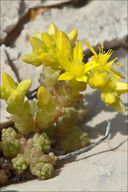|
|
click photo for larger file

Sedum sexangulare
Tasteless Stonecrop
|
Photographer: Dr. Amadej Trnkoczy
ID: 0000 0000 0123 1588 (2023-01-12)Copyright © 2023 Dr. Amadej Trnkoczy
|
|
INFORMATION PROVIDED WITH THE PHOTO
|
date of photo May 23, 2022
latitude 44.81544 longitude 14.34782
View on Google Maps.
location
Adriatic Sea, island Cres, sea shore south of village Martinšćica, Kvarner bay (Rijeka region, Croatia)family
Crassulaceae
notes Slo.: šesterokotna homulica - syn.: Sedum boloniense Loisel., Sedum tschernokolevii Stef., 'Sedum mite' sec. auct., Sedum forsterianum Rchb., Sedum acre subs. sexangulare (L.) O.Schwartz - Habitat: Rocky sea shore; inclined terrain, southeast aspect, a few meters from the sea; full sun, hot, dry, open terrain, exposed to direct rain; elevation 3-6 m (10 -20 feet); average precipitations ~ 1.000 mm/year, average temperature 13-14 deg C, Sub-Mediterranean phytogeographical region. - Substratum: soil in rocks crevices. - Comment (pertains to pictures in the Flickr album Sedum sexangulare): Sedum sexangulare is a succulent species with mainly European native distribution. It grows now introduced also in UK, USA and Canada. In Slovenia 15 taxa of genus Sedum are described and in Croatia about 30. Most of them are variable plants and their taxonomy, particularly in Sedum acre agg. group, is not yet settled completely (Ref.4). - Sedum sexangulare can be recognized by its typical arrangement of leaves, which, when looked at from above, form a six leg star (sexangulare!) (Fig. 10). This arrangement is most distinctive on sterile, not too old and not too young shots. When shots are very young they have very compressed leaves of different size and this arrangement is not so apparent. When they are old and having inflorescence their stem lengthens during anthese very much and this arrangement is again not so obvious and distinctive. There are other traits typical for this species: cross-section of the leaves is almost circular (leaves are cylindrical in shape), at the top they are blunt, and at the point where they are attached to the stem they have an inconspicuous 'spur' or 'dent'. Petals are acute. - Sedum sexangulare usually grows in quite large mats, sometime one meter or more wide. On my pictures the plants thrive in an extremely nutrition poor, rocky environment, in almost barren rock next to the sea shore. Hence they are mostly 'individuals'. The plant is widely used in gardening as an excellent ground cover. - Ref.: - (1) Personal communication with Mrs. Ljiljana Borovečki-Voska, Zagreb, Croatia. (2) D. Aeschimann, K. Lauber, D.M. Moser, J.P. Theurillat, Flora Alpina, Vol. 1., Haupt (2004), p 682. (3) A. Martinči et all., Mala Flora Slovenije (Flora of Slovenia - Key) (in Slovenian), Tehnična Založba Slovenije (2007), p 236. (4) T. Nikolić, Flora Croatica, Vaskularna flora Republike Hrvatske, Vol. 2., Alfa d.d.. Zagreb (2020) p 651.camera Sony ILCE6000 / Carl Zeiss Vario-Tessar E 16-70 mm/f4
contributor's ID # Bot_1469/2022_DSC8145 photo category: Plant - annual/perennial
|
MORE INFORMATION ABOUT THIS PLANT
|
| common names
Tasteless Stonecrop (photographer)
View all photos in CalPhotos of Sedum sexangulare Check Google Images for Sedum sexangulare |
|
The photographer's identification Sedum sexangulare has not been reviewed. Click here to review or comment on the identification. |
|
Using this photo The thumbnail photo (128x192 pixels) on this page may be freely used for personal or academic purposes without prior permission under the Fair Use provisions of US copyright law as long as the photo is clearly credited with © 2023 Dr. Amadej Trnkoczy.
For other uses, or if you have questions, contact Dr. Amadej Trnkoczy amadej.trnkoczy[AT]siol.net. (Replace the [AT] with the @ symbol before sending an email.) |
|
|
